H3C GB0-372-ENU H3CSE-RS-SW Online Training
H3C GB0-372-ENU Online Training
The questions for GB0-372-ENU were last updated at Feb 19,2025.
- Exam Code: GB0-372-ENU
- Exam Name: H3CSE-RS-SW
- Certification Provider: H3C
- Latest update: Feb 19,2025
In the network shown in the figure, after completing the corresponding configuration on the switch SWA, when the switch SWA receives the data frame accessing the PCB from the PCA, it determines whether to check the MAC address table or the routing table?
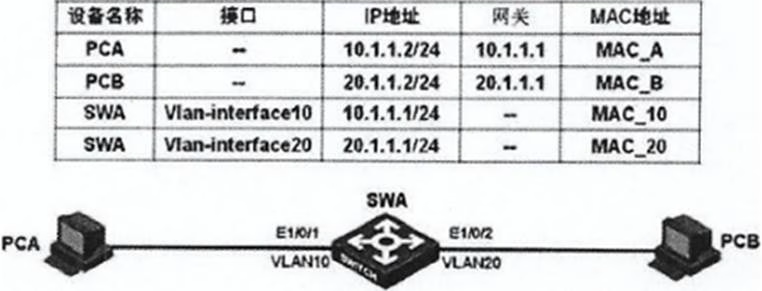
- A . VLAN attributes of data frames
- B . Destination MAC address of the data frame
- C . Source MAC address of the data frame
- D . Source MAC address of the data frame
- E . Source IP address of the data frame
Which of the following descriptions about H3C switch static routing is correct?
- A . Layer 2 switches do not support routing forwarding, so static routing cannot be configured on Layer 2 switches.
- B . Layer 2 switches can be configured with static routing
- C . Only Layer 3 switches can be configured with static routing
- D . When configuring static routing, the switch can directly specify the outbound interface without specifying the next hop.
Two routers are connected together through a LAN to form a VRRP backup group. The VRRP timer is configured on each interface as follows:
[RTA-GigabitEthernet1 /0] vrrp vrid 1 timer advertise 5
[RTB-GigabitEthernet1/O] vrrp vrid 1 timer advertise 5
VRRP backup group 1 runs normally, RTA is the Master, and RTB is the Backup. If the device runs for a period of time and router RTA fails, the time for router RTB to change from Backup to Master may be?
- A . 3 seconds
- B . 5 seconds
- C . 12 seconds
- D . 20 seconds
SNMP protocol uses C/S structure and uses UDP to realize message transmission. In order to ensure the normal interaction of protocol messages between network management workstation and SNMP, they both need to listen to specific UDP port numbers. Which of the following statements about them is correct?
- A . Both the network management workstation and the SNMP agent listen to UDP port 161
- B . Both the gateway workstation and the SNMP agent listen on UDP port 162
- C . The gateway workstation listens to UDP port 161, and the SNMP agent listens to UDP port 162
- D . The gateway workstation listens to UDP port 162, and the SNMP agent listens to UDP port 161
In the switching network shown in the figure, VLAN 10 is set as the Super VLAN on the switch SWA, and VLAN 2 and VLAN 3 are sub VLANs of VLAN 10. VLAN, port Ethernet1/0/3 is a Trunk port, PVID is VLAN1, and all VLANs are allowed to pass; VLAN2 and VLAN20 are created on switch SWB, port Ethernet1/0/4 is a Trunk port, PVID is VLAN1, and all VLANs are allowed to pass. After setting the IP addresses of each device as shown in the figure, it can be determined that which of the following statement is correct?



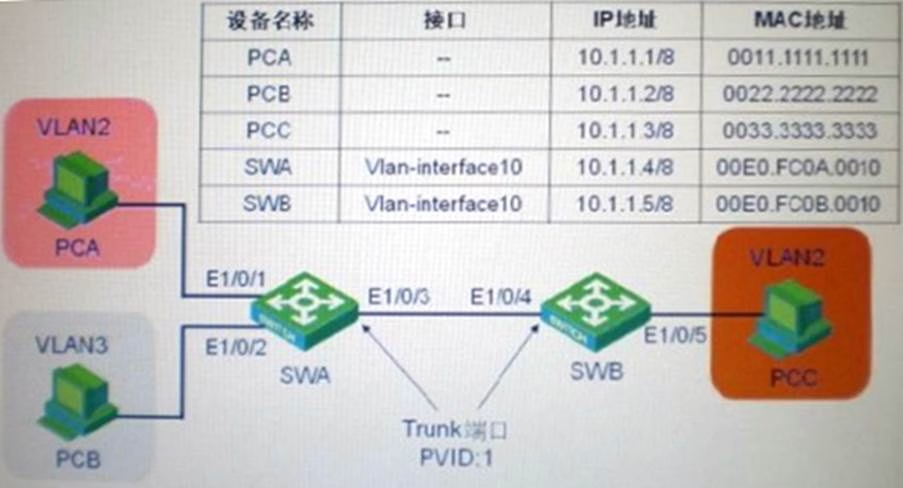
- A . PCA’s message enters from SWA’s Ethernet1/0/1 port and exits from Ethernet1/0/3 port without a tag
- B . PCA’s message enters from SWA’s Ethernet1/0/1 port and exits from Ethernet1/0/3 port with VLAN Tag VLAN 1
- C . The PCA message enters from the Ethernet1/0/1 port of SWA and comes out from the Ethernet1/0/3 port with the VLAN Tag of VLAN2
- D . The PCA message enters from the Ethernet 1/0/1 port of SWA and comes out from the Ethernet 1/0/3 port with the VLAN Tag of VLAN 10.
As shown in the title figure, SWA, SWB, SWC and SWD have STP enabled. SWA, SWB and SWC form a loop. After the topology is stable, SWD and SWB are connected. Assuming that the cost of each link is the same, which of the following statements about the topology change process of STP are correct?
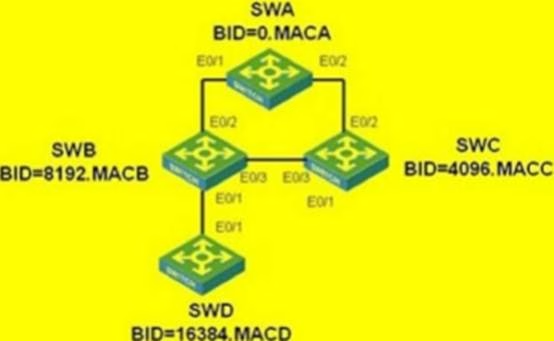
- A . SWD will send TCN BPDU from port E0/1
- B . SWB will send TCN BPDU from port E0/2
- C . If the link between SWC and SWA is disconnected, SWC will send a TCN BPDU from port E0/3
- D . If the link between SWB and SWC is disconnected, both SWB and SWC will send TCN BPDUs from port EO/2.
Which of the following statements about the generation of TCNBPDU is correct?
- A . If a port of a non-root bridge switch with STP enabled is connected to a PC, the switch will not generate TCN BPDU when the port enters the forwarding state.
- B . If the link of a designated port of a switch in the network is broken, the switch will definitely generate a TCNBPDU
- C . If the alternate port of a switch in the network is down, the switch will not generate TCN BPDU
- D . When a switch port is selected as a designated port or root port, the switch will immediately send TCNBPDU
Switches SWA and SWB are connected together through two optical fiber Gigabit Ethernet links, and the following interface configuration is available on switch SWA:
[SWA] interface GigabitEthernet 1/0/1
[SWA-GigabitEthernet1/0/1] gvrp
[SWA-GigabitEthernet1/0/1] port link-type trunk
[SWA-GigabitEthernet1/0/1] port trunk permit vlan 1 10
[SWA] interface GigabitEthernet 1/0/2
[SWA-GigabitEthernet1/0/2] port link-type trunk
[SWA-GigabitEthernet1/0/2] port trunk permit vlan 1 10
If you want to configure link aggregation to aggregate these two links, if the configuration on SWB is correct, which of the following you can know from the above information?
- A . Only when all VLANs are allowed to pass through GigabitEthernet1/0/2 and Gigabit1/0/1, can the two be added to the same aggregation group.
- B . Only when the configuration of GigabitEthe1/0/2 is changed to be consistent with that of GigabitEthe1/0/1, can the two be added to the same aggregation group.
- C . After link aggregation is configured on SWA and SWB, if both SWA and SWB enable MSTP on the aggregation port, one of GigabitEthe1/0/1 and GigabitEthe1/0/2 will be blocked.
- D . After link aggregation is configured on SWA and SWB, if both SWA and SWB enable MSTP on the aggregation ports, GigabitEthernet1/0/1 and GigabitEthe1/0/2 can participate in forwarding.
In the switching network shown in the figure, VLAN 10 is set as lsolate-user-vlan on switch SWA, and VLAN 2 and VLAN 3 are set as Secondary VLAN of VLAN 10; VLAN 20 is created on switch SWB, and VLAN 20 is set as lsolate-user-vlan, and VLAN 4 is set as Secondary VLA of VLAN 20. After setting the IP addresses of each device as shown in the figure, the local proxy ARP function is enabled on SWA and SWB. Initially, the switch and PC did not learn their corresponding ARP entries. When PCA pings PCB, PCA will send an ARP request. What is the source MAC address of the ARP request message forwarded by the switch to PCB?
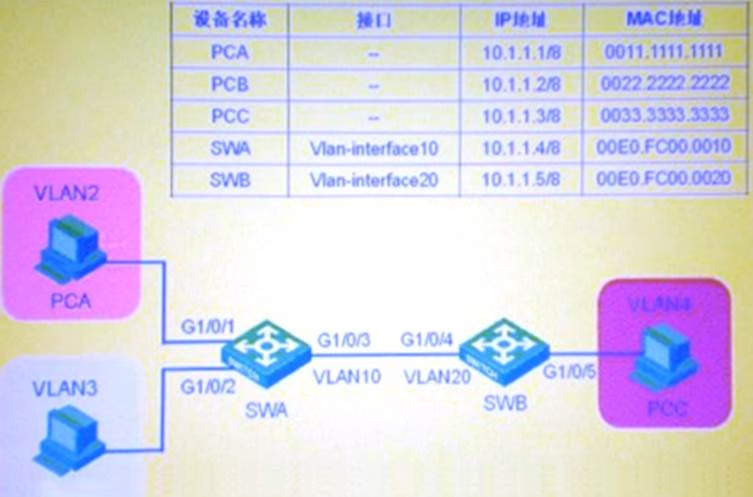
- A . 0000.0000.0000
- B . 0011.1111.1111
- C . 00E0.FC00.0010
- D . 00E0.FC00.0020
In the network shown in the figure, switch SWA is a layer 2 switch, and router RTA is the gateway of each PC. The following configuration is made on router RTA:
[RTA] interface Ethernet 0/0.1
[RTA-Ethernet0/0.1] ip address 10.10.10.1 255.255.255.0
[RTA-Ethernet0/0.1] vlan-type dotlq vid 1
[RTA-Ethernet0/0.1] interface ethernet 0/0.2
[RTA-Ethernet0/0.2] ip address 20.20.20.1 255.255.255.0
[RTA-Ethernet0/0.2] vlan-type dotlq vid 2
[RTA-Ethernet0/0.2] interface ethernet 0/0.3
[RTA-Ethernet0/0.3] ip address 30.30.30.1 255.255.255.0
[RTA-Ethernet0/0.3] vlan-type dotlq vid 3
After completing the configuration on switch SWA, PCA, PCB, and PCC can all ping their own gateways. Which of the following is correct about switch SWA port Ethernet1/0/4?
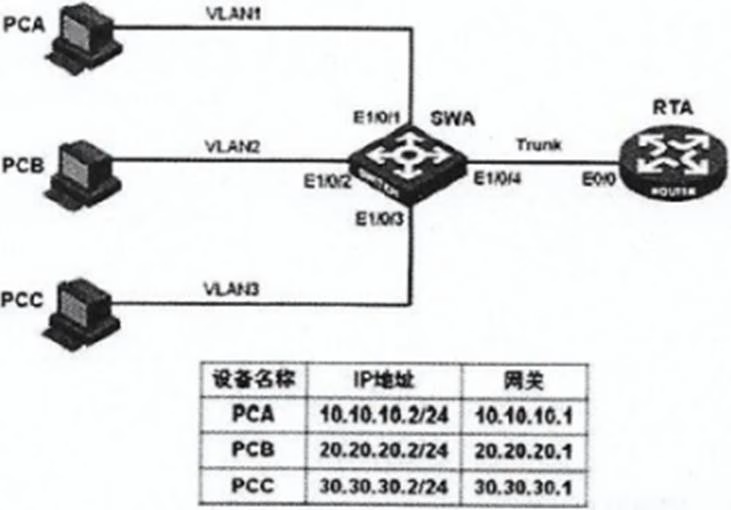
- A . interfaceEthernet1/0/4 port link-mode bridge port link-type trunk
Port trunk permit vlan all - B . interfaceEthernet1/0/4 port link-mode bridge port link-type trunk
Port trunk permit vlan all port trunk pvid vlan 2 - C . interface Ethernet1/0/4 port link-mode bridge port link-type trunk
Port trunk permit vlan all port trunk pvid vlan 3 - D . interface Ethernet 1/0/4 port link-mode bridge port link-type trunk
Port trunk permit vlan all port trunk pvid vlan 10
Latest GB0-372-ENU Dumps Valid Version with 432 Q&As
Latest And Valid Q&A | Instant Download | Once Fail, Full Refund

